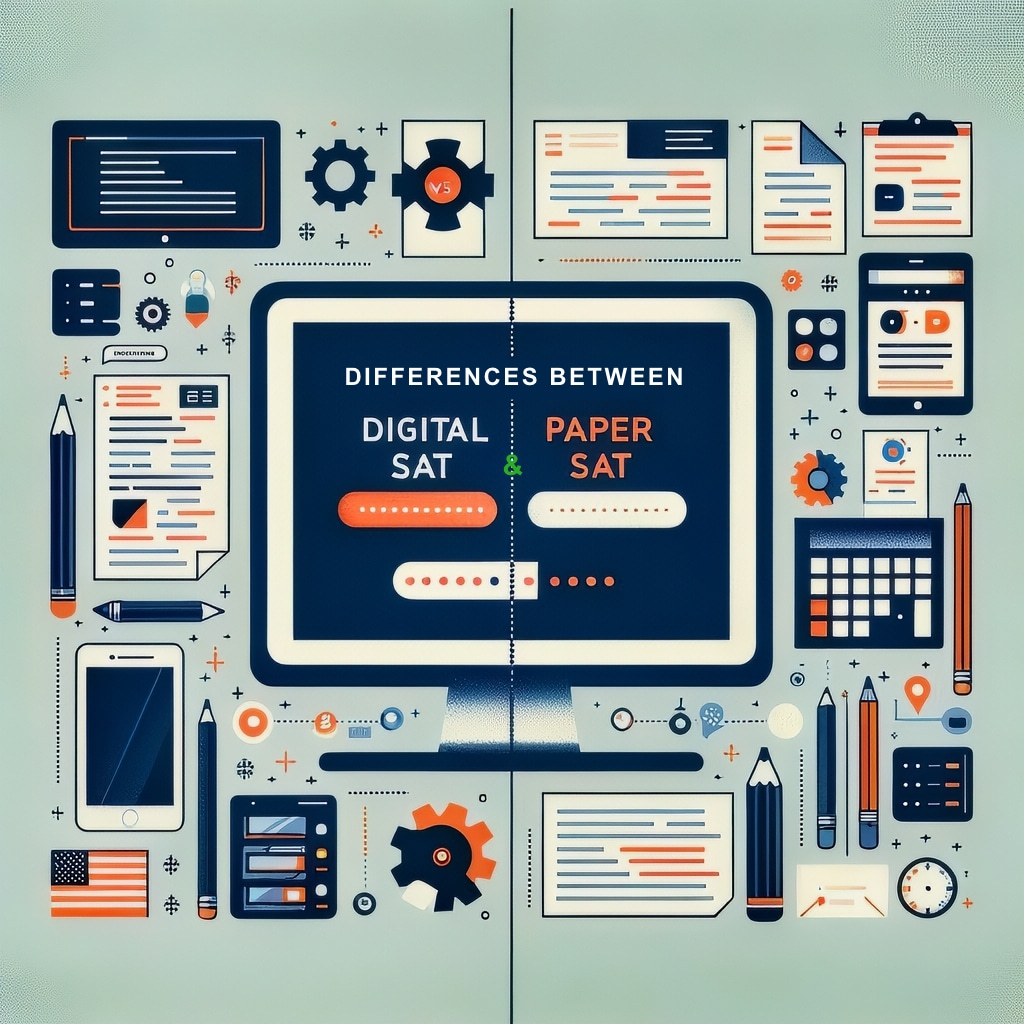
Navigating the New Era: Digital SAT vs. Paper SAT
The SAT’s transition from paper to digital marks a significant shift in the landscape of standardized testing, shaping the future for today’s students. This guide delves into the transformation of this iconic assessment, a tradition for generations, as it navigates to an updated online SAT format. Understanding these changes is critical to thriving in the SAT’s digital era.
As we move into this new era, students are required to adapt to the digital environment that introduces a host of new features. With its adaptive testing model, the digital SAT personalizes the experience for each test-taker. This innovative approach adjusts the difficulty of questions based on real-time performance, offering a more tailored and efficient assessment. Furthermore, the digital format includes built-in tools such as highlighting, flagging questions, and an on-screen calculator, adding a layer of convenience and adaptability to the test-taking experience.

Navigating the New Era: Digital SAT vs. Paper SAT
The SAT’s transition from paper to digital marks a significant shift in the landscape of standardized testing, shaping the future for today’s students. This guide delves into the transformation of this iconic assessment, a tradition for generations, as it navigates to an updated online SAT format. Understanding these changes is critical to thriving in the SAT’s digital era.
As we move into this new era, students are required to adapt to the digital environment that introduces a host of new features. With its adaptive testing model, the digital SAT personalizes the experience for each test-taker. This innovative approach adjusts the difficulty of questions based on real-time performance, offering a more tailored and efficient assessment. Furthermore, the digital format includes built-in tools such as highlighting, flagging questions, and an on-screen calculator, adding a layer of convenience and adaptability to the test-taking experience.
Why this matters
The digital revolution has arrived for the SAT, bringing significant changes. For students taking the test in 2024 and beyond (in The USA), success requires preparation and strategy tailored to the digital format. Becoming familiar with the online experience now is key to avoiding stress later. This transition opens new possibilities but also requires adapting existing approaches.
| Year | Milestone |
|---|---|
| 1926 | SAT debuts as "Scholastic Aptitude Test" |
| 1994 | "SAT I Reasoning Test" introduced |
| 2005 | SAT format revised and renamed simply the "SAT" |
| 2014 | SAT redesign focuses on assessing college readiness |
| 2023 | Digital SAT launches internationally |
| 2024 | All students globally transition to digital SAT |
| Format | Length | Composition |
|---|---|---|
| Digital SAT | 2 hours 14 minutes | 4 modules |
| Paper SAT | 3 hours + 50 minute optional essay | 5 sections |
| Format | Passage Length |
|---|---|
| Digital SAT | 100 words |
| Paper SAT | 500-750 words |
SAT IS ADAPTIVE NOW
The digital SAT features an adaptive testing system that modifies the difficulty of questions according to your live performance. This tailored method makes sure that you’re appropriately challenged during the test, avoiding any sense of being overburdened or under-stimulated. The algorithm continuously assesses how you’re doing and customizes the following questions to suit your level. Such a responsive approach results in a more precise evaluation of your abilities, accurately highlighting your areas of strength and improvement.
The advantages of adaptive testing are provided below
| Adaptive Testing | Linear Testing |
|---|---|
| Questions are adjusted based on real-time performance | Questions have a fixed difficulty level |
| Challenges students at their appropriate level | May not provide an accurate assessment of student ability |
| Can reduce test anxiety | Can increase test anxiety due to inconsistent difficulty |
| Provides more personalized feedback | Feedback is based on a set of questions with a fixed difficulty level |
| May lead to more accurate scores | May not accurately reflect student's full range of abilities |
New Built-in Digital Tools
Unique digital tools also facilitate the process:
- Flag questions to revisit
- Highlight key text in reading passages
- Perform math with an on-screen calculator (Desmos)
- Eliminate answer choices
The digital SAT’s embedded Desmos graphing calculator removes barriers and creates opportunities. Previously, students had to supply their own approved calculator for the math section, with feature-rich graphing calculators often costing over $100 and putting them out of reach for some. Now, all students can access the powerful, acclaimed Desmos calculator right on the testing device free of charge. This high-quality tool offers advanced graphing, geometry, and calculation capabilities.
Paired with an affordable scientific calculator, students who have practiced using both calculators effectively can leverage Desmos and these complementary tools in tandem to unlock maximum potential.
Having critical math formulas and constants available alongside these graphing resources is also invaluable. The digital Desmos grants all students, regardless of means, an equal chance at tapping into sophisticated capabilities once exclusive to those with access to expensive graphing calculators.
Of course, avoiding overreliance and building foundational skills remain imperative. But mastering this powerful calculator rewards creativity and perseverance with a formidable asset on test day.
Preparing for the Digital Era
Some students feel apprehensive about computer-based tests. However, success requires focusing on core competencies over format. The digital SAT still measures key reading, writing, and math abilities, indicating college readiness – just in an updated package.
Students can adapt by taking practice exams to gain digital fluency, which the College Board offers. Avoiding online distractions and sticking to the time limits are also critical.
This transition brings new possibilities. Students who embrace an agile, solution-focused mindset will be primed to excel in the digital era.
WHERE TO FIND US
Vancouver Office
2030 Marine Drive,
North Vancouver, BC, V7P 1V7, Canada
Email: info@ibaptutoring.com
Seattle Office
5608 17th Avenue NW, Suite 1578
Seattle, WA 98107, USA
Email: info@ibaptutoring.com
Toronto Office
99 Yorkville Avenue
Toronto, ON M5R 1C1, Canada
Email: info@ibaptutoring.com
